Spherical Crystallization for Lean Solid-Dosage Manufacturing (Part II)
In Part I of this article, which appeard in the March 2010 issue, the authors describe their approach for constructing form spaces for carbamazepine, cimetidine, and phenylbutazone by initial solvent screening to evaluate the feasibility of spherical crystallization. Part II of this article discusses their findings.
Part 1 of this article, which appeared in the March 2010 issue of Pharmaceutical Technology, described a robust miniaturized screening strategy to accelerate the preparation and characterization of spherical agglomerates produced by spherical crystallization (1). This approach can be readily adopted or automated using only a small amount of active pharmaceutical ingredient (API), so spherical crystallization can be performed before the submission of a new drug application. The authors described their approach for constructuring form spaces for the nonionizable APIs, carbamazepine, cimetidine, and phenylbutazone by initial solvent screening of 19 common organic solvents to evaluate the feasibility of spherical crystallization. The materials and methods for this study were outlined in Part I of this article (1). Part II of this article discusses the results.
Results and discussion
Identification tests. The differential-scanning-calorimetry (DSC) identification-test scan of the purchased carbamazepine exhibited the first endothermic peak at 170–174 °C, which corresponded to the melting of Form III (2). An exothermic peak at 175 °C followed, which corresponded to the crystallization of Form I (2). A second endothermic peak at 193 °C corresponded to the melting of Form I (2). The DSC identification-test thermogram of the purchased phenylbutazone displayed a single endothermic peak around 105 °C, which corresponded to the melting of Form A (3). The polymorphism of the purchased carbamazepine and phenylbutazone, therefore, were Form III and Form A, respectively, at room temperature. The identification test for cimetidine was performed using Fourier transform infrared (FTIR) spectroscopy instead of DSC because the melting points of the different forms of cimetidine were very close to each other (4).
The FTIR spectrum showed four significant infrared peaks for Form A cimetidine at 1204, 1156, 1077, and 954 cm-1 and two well-resolved characteristic peaks at 1243 and 1228 cm-1, which indicated the polymorphism of the purchased cimetidine at room temperature was Form A (5–7). Two cimetidine molecules formed a dimer unit in Form A with an eight-member ring through the hydrogen bonds between N(10)H of one molecule and the N(12) of the other molecule (1). The cimetidine molecule could absorb water at the N(1)H group (8). The imidazolium peaks were at 1204 and 954 cm-1 (8, 9). The peak at 1077 cm-1 was attributed to a CH deformation and a ring deformation (8, 10). The peak at 1156 cm-1 was either a coupled ring and a CH-bending mode or the deprotonation of the N(1)H group on the complexation with a water molecule (8, 10).
Form spaces. To construct the form space for an API, which contains the possible solvent combinations for discovering a new polymorph, the 19 common solvents for scale-up listed in the materials and methods section of Part I of this article were arranged from top to bottom vertically and from left to right horizontally in ascending order of the solvent's Hildebrand value (1). This arrangement resulted in a 19 × 19 matrix of 361 boxes (see Tables 1(a), 1(b), and 1(c)). Each box represented a specific binary solvent combination except for the 19 boxes located diagonally in the matrix stepping down from the upper left-hand corner to the lower right-hand corner. The 19 diagonal boxes represented the 19 pure-solvent systems. The yellow boxes were the good solvents (i.e, defined as a solvent that gave solubility of ≥ 5 mg/mL at 25 °C) and the red boxes the bad solvents (i.e, defined as a solvent that gave solubility of ≤ 5 mg/mL at 25 °C) with respect to a particular API. The yellow and red boxes were the materials properties of the API. The gray boxes also were determined experimentally. They represented the immiscible solvent pairs that were independent of the API. Once the locations of the red, yellow, and gray boxes were fixed, the location of the green, blue, and white boxes representing the antisolvent system (i.e., a good solvent and a bad solvent), the good cosolvent system (i.e, a good solvent and a good solvent) and the bad cosolvent system (i.e,. a bad solvent and a bad solvent), respectively, were deduced graphically from the diagonal boxes. Since the 19 × 19 matrix was symmetrical along the diagonal boxes, the actual possible solvent combinations were reduced from 361 boxes to a total of 190 boxes or less (i.e., derived from 19 + (361 – 19) ÷ 2 = 190) because it is impractical to perform experiments in the white-boxed areas.
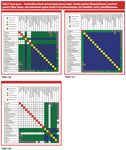
Table I
The actual form space of carbamazepine had 13 yellow, 6 red, 69 green, 78 blue, 14 gray, and 10 white boxes (see Table I (a)). The actual form space of cimetidine contained 5 yellow, 14 red, 66 green, 10 blue, 14 gray and 81 white boxes (see Table I (b)). The actual form space of phenylbutazone was composed of 17 yellow, 2 red, 22 green, 135 blue, 14 gray and 0 white boxes (see Table I (c)). The actual form spaces would have been expanded significantly if various solvent compositions of binary mixtures, temperatures, and ternary solvent systems were considered (10–12).
The solubility values of carbamazepine, cimetidine, and phenylbutazone in their corresponding solvents at 25 °C were listed in Table II. Most of the good solvents of Form III carbamazepine belonged to Class 1 (i.e., a protic hydrogen-bond-donating solvents [Lewis acids]), Class 2 hydrogen-bond-acceptor solvents [Lewis bases]), and Class 3 polar aprotic solvents, which were capable of disrupting the N–H•••O hydrogen bonds and the C–H•••O weak interactions of the carboxamide dimer units existing in the solid state of all forms of carbamazepine (2, 13). The good solvents for Form A cimetidine were mainly Class 1 solvents, which had the capability of interacting readily with the weakly basic imidazole ring and disrupting the N–H•••N hydrogen bonds of the dimer units existing in the solid state of Form A cimetidine (8, 13, 14). The good solvents for Form A phenylbutazone were Classes 1, 2, and 3 solvents, Class 4 chlorocarbon solvents, and Class 5 hydrocarbon solvents. This result implied the intermolecular interactions in the crystal lattice of phenylbutazone were dominated by van der Waals forces (i.e., dipole-dipole interactions and London dispersion force) (15).
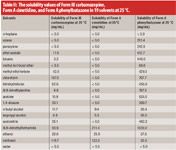
Table II
Spherical crystallization. The spherical agglomeration (SA) method was used in spherical crystallization. Because all miscible pairs of a good solvent and a bad solvent (i.e., an antisolvent) were represented by the green boxes and all immiscible pairs of a bad solvent and a bridging liquid were designated by the gray boxes in the actual form space of each API, the total number of combinations of a good solvent and a bad solvent and a bridging liquid was equal to (the sum of the number of green boxes in each column with a red box × the number of gray boxes in the same column) and (the number of green boxes in the bottom row with a red box × the number of gray boxes in the same bottom row), if water were also a bad solvent symbolized by a red box situated at the bottom right-hand corner of the actual form space.
The number of combinations for the SA method based on Table 1(a) for carbamazepine is 183 (i.e., derivied from 10 × 4 + 12 × 2 + 13 × 1 + 13 × 1 + 13 × 1 + 8 × 10 = 183). The number of combinations for the SA method based on Table 1(b) for cimetidine is 100 (i.e., derived from 3 × 4 + 4 × 2 + 5 × 1 + 5 × 1 + 5 × 1 + 5 × 1 + 5 × 1 + 5 × 1 + 5 × 1 + 5 × 1 + 4 × 10 = 100). The number of combinations for the SA method based on Table 1(c) for phenylbutazone was 136 (i.e., derived from 14 × 4 + 8 × 10 = 136).
Using the SA method, five types of behavior were observed:
- Type 1: No solid production upon the addition of 10 mL of an antisolvent to 2 mL of an API solution at 25 °C
- Type 2: Dissolution of the solids upon the addition of the bridging liquid at 25 °C
- Type 3: No agglomeration upon the addition of the bridging liquid at 25 °C
- Type 4: Nonspherical agglomeration upon the addition of the bridging liquid at 25 °C
- Type 5: Spherical agglomeration upon the addition of the bridging liquid at 25 °C.
Type-3 behavior was not observed with phenylbutazone.
In Type-1 and Type-2 behaviors, the solubility and the width of a metastable zone of an API solid were profoundly related to the molecular interactions among API solutes and solvents in a real solution system, which were dependent on the molecular structure of an API, the physical nature of a solvent, temperature, and compositional ratios of the solvent combinations (10, 12, 16, 17). In Type-3, Type-4, and Type-5 behaviors, the agglomeration process was intricately related to the balance between the drag force and the liquid-bridge strength (18, 19). The drag force was dependent on the speed of agitation, the viscous force, and the growing diameter of an agglomerate (18, 19). The liquid-bridge strength relied on the low pressure in the bridging-liquid phase led by the curvature of the bridging-liquid interface. The curvature of the bridging liquid was a function of: the interfacial tension of the bridging liquid and the mother liquor; the surface tension between the API crystals and the bridging liquid; the solubility of the API at the interface between the bridging liquid and the mother liquor; and the geometry of the API crystals (18–21).
Only 10 solvent combinations from a total of 183 combinations produced decent spherical agglomerates of carbamazepine. Only 4 from a total of 100 solvent combinations produced decent spherical agglomerates of cimetidine and 4 of 136 solvent combinations produced decent spherical agglomerates of phenylbutazone. Water was present in 18 workable combinations as an antisolvent (i.e., derived from 10 + 4 + 4 = 18). This observation agreed with the many reported experimental conditions that water could be used as an antisolvent for nonionizable organic compounds (22–43). If only the solvent combinations with water as an antisolvent were considered, the total number of solvent combinations would have been reduced from 183 to 80 for carbamazepine, from 100 to 40 for cimetidine and from 136 to 80 for phenylbutazone. The criterion of using water as an antisolvent, therefore, was essential to accelerate the screening activities. The aqueous-solution environment induced the formation of crystal surfaces with hydrophilic functionalities, which helped to sustain the curvature of the hydrophobic solvents (44). This result may explain why most of the bridging liquids in the 18 workable solvent combinations were Class-4 chlorocarbon or Class-5 hydrocarbon solvents.
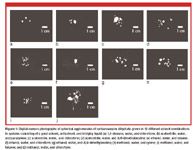
Figure 1 (ALL FIGURES ARE COURTESY OF THE AUTHORS)
Solvent combinations for carbamazepine. The 10 solvent combinations of good solvent, antisolvent, and bridging liquid for carbamazepine were: 1,4-dioxane, water, and chloroform; acetonitrile, water, and paraxylene; acetonitrile, water, and chloroform; acetonitrile, water, and N,N-dimethylaniline; ethanol, water, and toluene; ethanol, water, and chloroform; ethanol, water, and N,N-dimethylaniline; methanol, water, and xylene; methanol, water and toluene; and methanol, water, and chloroform. All carbamazepine spherical agglomerates (see Figure 1) were freshly made as the dihydrate, which was the thermodynamically stable form in the aqueous system (45, 46). They were first oven-dried at 100 °C for 4 h to become Form I before being subjected to characterization by a scanning electron microscope (SEM), whose high-vacuum system could be contaminated by the dehydration of the dihydrate form. Although the solubility of Form I carbamazepine was less than the solubility of Form III, it was advantageous to make Form I carbamazepine spherical agglomerates for several reasons (47). Form I transformed to dihydrate at a slower rate than Form III did in an aqueous environment, and the solubility of the dihydrate was known to be about 1.3 times less than the solubility of any of the anhydrous form (48). Also, the difference in the solubility values between Forms I and III was relatively small, and the area under the curve in bioavailability tests of the forms were in the order of Form I > Form III < dihydrate. Lastly, Form I was stable below 71 °C (47).

Figure 2
Solvent combinations for cimetidine.The four solvent combinations of good solvent, antisolvent, and bridging liquid for cimetidine were: methanol, water, and n-heptane; methanol, water, and xylene; methanol, water, and paraxylene; and methanol, water, and toluene. All cimetidine spherical agglomerates (see Figure 2) were made of Form C crystals as verified by the FTIR spectrum with Form C characteristic bands at 1066, 1182, 1229, and 1347 cm-1 (5). Even though Form A is thermodynamically less stable than Form C under normal pressure, Form A was preferable for medicine because of Form C's extraordinarily poor bulk flowability for tableting (4, 6). The feasibility of producing Form C cimetidine spherical agglomerates, however, might have made the industrial tablet production of Form C cimetidine possible.

Figure 3
Solvent combinations for phenylbutazone.The four different solvent combinations of good solvent, antisolvent, and bridging liquid for phenylbutazone were: tetrahydrofuran, water, n-heptane; 1,4-dioxane, water, and n-heptane; acetonitrile, water, and n-heptane; methanol, water, and n-heptane. Spherical agglomerates (see Figure 2) of the first two cases were made of Form E crystals (see Figure 3), whereas the last two cases were made of Form A crystals as indicated by DSC. Form A showed only a single melting endotherm at 105 °C for Form A, but the DSC thermogram (see Figure 4) exhibited the first endothermic peak at 92.5 °C , which corresponded to the melting of Form E (3). This peak was followed by an exothermic peak at 95 °C, which corresponded to the crystallization of Form E (3). A second endothermic peak at 104 °C corresponded to the melting of Form A (3). Because the equilibrium solubility and the dissolution rate of the phenylbutazone crystal forms were in the order of Form C > Form E> Form D > Form B > Form A and Form C > Form E > Form B > Form D > Form A, respectively, spherical agglomeration might offer a way of tuning the dissolution profile of phenylbutazone by the change of polymorphism in addition to providing good bulk flowability.
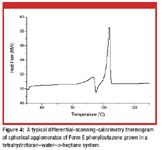
Figure 4
Powder characteristics. The polymorphism of the API solids remained unchanged before and after the addition of a bridging liquid in the previoulsy described 18 solvent systems. Other powder characteristics of the spherical agglomerates from the 18 solvent systems such as the percent yield, the length-mean diameter, the apparent density, the population density, the sphericity, and the friability index were fully analyzed based on the sample weight and digital-camera photographs and were calculated according to Equations 1–6 as follows (22, 26, 40):
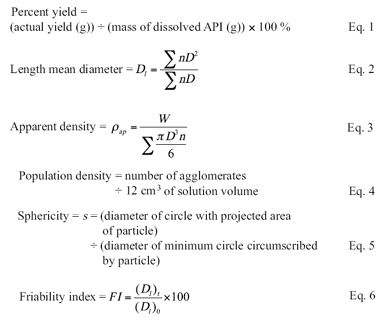
where D is agglomerate diameter (cm); Dl is length-mean agglomerate diameter (cm); n is number of agglomerates of size D; W is the total weight of solids (g); (Dl)t is length-mean agglomerate diameter (cm) after 30 min, and (Dl)0 is length-mean agglomerate diameter (cm) at the beginning of the friability test. The volume of a bridging liquid and the angle of repose were entirely determined by experiments. The sample sizes varied greatly from numerous powder-like agglomerates to one large aggregate as revealed clearly in Figures 1, 2, and 3. No replicate was made for each test at this point due to the limitation of time and materials. All experimental and calculated results are summarized in Table III.
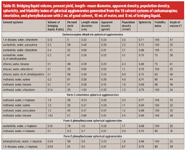
Table III
Spherical agglomerates of carbamazepine dihydrate from an acetonitrile–water–paraxylene system, Form C cimetidine from a methanol–water–xylene system, Form E phenylbutazone from a tetrahydrofuran–water–n-heptane system, and Form A phenylbutazone from an acetonitrile–water–n-heptane system gave relatively high yields, high friability indices (i.e., greater strength) and low angles of repose (i.e., good bulk flowability) among the other spherical agglomerates produced by other systems. Therefore, they were first chosen as candidates for further scale-up or preformulation studies. Rotation in a cylindrical vessel alone did not encourage the formation of spherical agglomeration because a control experiment confirmed that spherical-shaped agglomerates could also be produced in a 500-mL sized crystallizer equipped with baffles and an overhead stirrer. The yield of each system was dependent on the compositional ratios of the solvent combinations. The yield can be easily raised during future process development by increasing the volume ratio of antisolvent to good solvent to values higher than 5:1.
Agglomerate structures. SEM images of the cross-section of all spherical agglomerates of carbamazepine dihydrate, Form C cimetidine, Form E phenylbutazone, and Form A phenylbutazone were categorized into four different typical modes. All primary crystals were needles and were: tangled with fibrils (see Figure 5(a)); randomly stacked together and linked by solid nodes (see Figure 5(b)); bundled together in parallel (see Figure 5(c)) and radiated from a center core; and jointed by solid bridges to form many A-shaped or H-shaped ladder structures (see Figure 5(d)) (49).

Figure 5
Because the volume ratio of water (i.e., the antisolvent) to good solvent was fixed at 5:1, the presence of a small amount of bridging liquid immiscible with water also would be immiscible with the saturated aqueous API solution and the good solvent as confirmed experimentally. Under a high speed of stirring, the bridging liquid was dispersed in the saturated aqueous API solution and the good solvent as tiny suspended droplets. These tiny droplets were randomly drawn to near the points of contact between the preformed needle-like primary crystals by interfacial tension. The fibrils, nodes and joints (see Figures 5 (a)–5 (d)) suggested that the dissolution of API would take place initially at the crystal–bridging liquid interface because of the relatively higher solubility power of the bridging liquid than the surrounding saturated high water content of the mother liquor. As the saturated high water content of the mother liquor diffused into the bridging-liquid region, recrystallization of the API occurred inside the liquid bridges.
Conclusion
The form space constructed from the common organic solvents by initial solvent screening provided a systematic way of finding ideal combinations of a good solvent, an antisolvent, and a bridging liquid for spherical agglomeration on a miniaturized scale. The same working logic could be extended to other solvent techniques such as the spreading of cube-shaped particles, monodispersed double emulsions, microemulsions, and organic nanocrystal fabrication (50–53). Powder characteristics of spherical agglomerates such as percent yield, length-mean diameter, apparent density, population density, sphericity, friability index, and angle of repose served as a selection guide for narrowing down the final feasible solvent combinations for future scale-up. The initial solvent screening method made it possible to identify the right solvent combinations for spherical crystallization early in drug development. This strategy, therefore, increases the possibility of direct tableting without performing granulation.
Acknowledgment
This work was supported by a grant from the National Science Council of Taiwan, R. O. C. (NSC 98-2113-M-008-008-006). Suggestions from Jui-Mei Huang in DSC and Ching-Tien Lin in SEM, both at the National Central University's Precision Instrument Center and High Valued Center are gratefully acknowledged.
Tu Lee* is an associate professor, and Yan Chan Su and Hung Ju Hou were graduate students in the department of Chemical and Materials Engineering, and Hsiang Yu Hsieh was a graduate student at the Institute of Materials Science and Engineering, all at National Central University, 300 Jhong-Da Rd., Jhong-Li City 320, Taiwan, ROC, tel. +886 3 422 7151 ext. 34204, fax +886 3 425 2296, tulee@cc.ncu.edu.tw.
To whom all correspondence should be addressed.
Submitted: Feb. 2, 2009; Accepted May 20, 2009.
References
1. T. Lee et al., Pharm. Technol. 34 (3), 72–75 (2010).
2. A.L. Grzesiak et al., J. Pharm. Sci. 92 (11), 2260–2271 (2003).
3. M.D. Tuladhar, J.E. Carless, and M.P. Summers, J. Pharm. Pharmacol. 35 (4), 208–214 (1983).
4. A. Bauer-Brandl, Intl. J. Pharm. 140 (2), 195–206 (1996).
5. B. Hegedüs and S. Görög, J. Pharm. Biomed. Analysis 3 (4), 303–313 (1985).
6. S. Sudo, K. Sato, and Y. Harano, J. Chem. Eng. Japan 24 (2), 237–242 (1991).
7. A.M. Tudor et al., Spectrochimica Acta 47A (9–10), 1389–139 (1991).
8. W.A. Bueno and E.G. Sobrinho, Spectrochimica Acta 51A (2), 287–292 (1995).
9. W.N. Richmond et al., J. Electroanalytical Chem. 448 (2) 237–244 (1998).
10. C.C. Chen and P.A. Crafts, Ind. Eng. Chem. Res. 45 (13), 4816–4824 (2006)..
11. A. Getsoian, R.M. Lodaya, and A.C. Blackburn, Int. J. Pharm. 348 (1–2), 3–9 (2008).
12. T. Lee and S.T. Hung, Pharm. Technol. 32 (1), 76–95 (2008).
13. T. Lee, C.S. Kuo, and Y.H. Chen, Pharm. Technol. 30 (10), 72–92 (2006).
14. G.J. Durant, J. Med. Chem. 20 (7), 901–906 (1977).
15. T. Hosokawa et al., Cryst. Eng. Comm. 6 (44), 243–249 (2004).
16. C. Rey-Mermet et al., Pharm. Res. 8 (5), 636–642 (1991).
17. R.A. Granberg and A.C. Rasmuson, J. Chem. Eng. Data 45 (3), 478–483 (2000).
18. A.Y. Huang and J.C. Berg, Colloids and Surfaces A: Physicochem. Eng. Aspects 215 (1-3), 241-252 (2003).
19. D. Rossetti, X. Pepin and S. J. R. Simons, J. Colloid and Interface Science 261 (1), 161–169 (2003).
20. E. Diaz-Herrera et al., J. Chem. Phys. 110 (16), 8084–8089 (1999).
21. H. Kahl, T. Wadewitz, and J. Winkelmann, J. Chem. Eng. Data 48 (6). 1500–1507 (2003).
22. Y. Kawashima and C.E. Capes, Powder Technol. 10 (1), 85–92 (1974).
23. Y. Kawashima and C.E. Capes, Powder Technol. 13 (2), 279–288 (1976).
24. Y. Kawashima, M. Okumura, and H. Takenaka, Science 216 (4550), 1127–1128 (1982).
25. Y. Kawashima et al., J. Pharm. Sci. 73 (10) 1407–1409 (1984).
26. Y. Kawashima, M. Okumura, and H. Takenaka, Powder Technol. 39 (1), 41–47 (1984).
27. Y. Kawashima et al., J. Pharm. Sci. 74 (11), 1152–1156 (1985).
28. A. Sano, Chem Pharm. Bull. 37 (8), 2183–2187 (1989).
29. Y. Kawashima et al., J. Pharm. Sci. 80 (5), 472–478 (1991).
30. K. Morishima et al., Powder Technol. 76 (1), 57–64 (1993).
31. Y. Kawashima et al., Powder Technol. 78 (2), 151–157 (1994).
32. K. Morishima et al., Int. J. Pharm. 105 (11), 11–18 (1994).
33. A.M. Garcia and E.S. Ghaly, J. Controlled Release 40 (3), 179–186 (1996).
34. A.H.L. Chow and M.W.M. Leung, Drug Dev. Ind. Pharm. 22 (4), 357–371 (1996).
35. U. Teipel, T. Heintz, and H.H. Krause, Propellants, Explosives, Pyrotechnics 25 (2), 81–85 (2000).
36. P. Szabó-Révész et al., Powder Technol. 114 (1), 118–124 (2001).
37. A.R. Paradkar et al., Drug Dev. Ind. Pharm. 28 (10), 1213–1220 (2002).
38. P. Szabó-Révész et al., J. Crystal Growth 237–239 (Part 3), 2240–2245 (2002).
39. Y. Kawashima et al., Powder Technol. 130 (1), 283–289 (2003).
40. A.P. Pawar et al., AAPS PharmSciTech. 5 (3), Article 44 (2004).
41. S. Bhadra et al., Pharm. Technol. 28 (2), 66–76 (2004).
42. M. Maghsoodi et al., Drug Dev. Ind. Pharm. 33 (11), 1216–1224 (2007).
43. J. Katta and A.C. Rasmuson, Int. J. Pharm. 348 (1–2), 61–19 (2008).
44. R. S. Abendan and J. A. Swift, Langmuir 18 (12), 4847–4853 (2002).
45. N. Rodríguez-Hornedo and D. Murphy, J. Pharm. Sci. 93 (2), 449–460 (2004).
46 F. Tian et al., J. Pharm. Sci. 96 (3), 584–594 (2007).
47. Y. Kobayashi et al, Int. J. Pharm. 193 (2), 137–146 (2000).
48. I. Katzhendler et al, J. Controlled Release 54 (1), 69–85 (1998).
49. Z. Wu et al., Cryst. Growth & Design 7 (12), 2454–2459 (2007).
50. X. Liu et al., Langmuir 21 (8), 3207–3212 (2005).
51. A.S. Utada et al., Science 308 (5721), 537–541 (2005).
52. S. Gupta and S.P. Moulik et al. J. Pharm. Sci. 97 (91), 22–45 (2008).
53. K. Ujiiye-Ishii et al., Cryst. Growth & Design 8 (2), 369–371 (2008).

Drug Solutions Podcast: A Closer Look at mRNA in Oncology and Vaccines
April 30th 2024In this episode fo the Drug Solutions Podcast, etherna’s vice-president of Technology and Innovation, Stefaan De Koker, discusses the merits and challenges of using mRNA as the foundation for therapeutics in oncology as well as for vaccines.